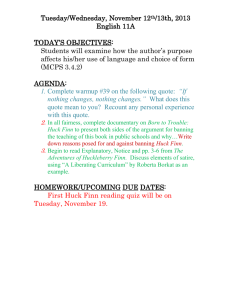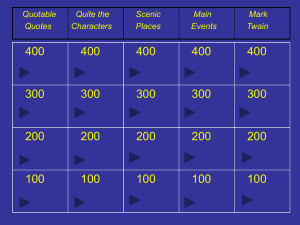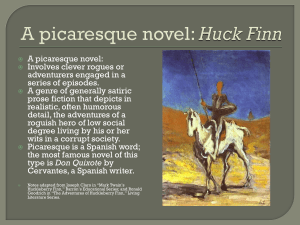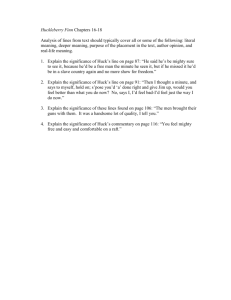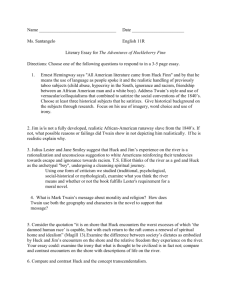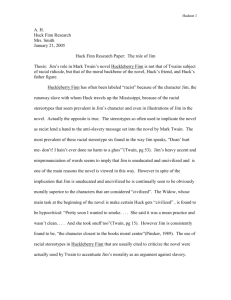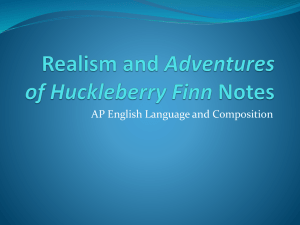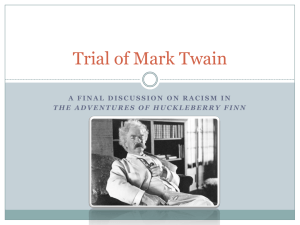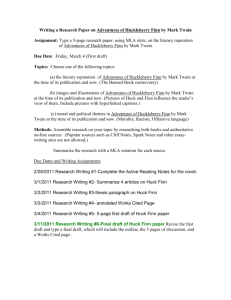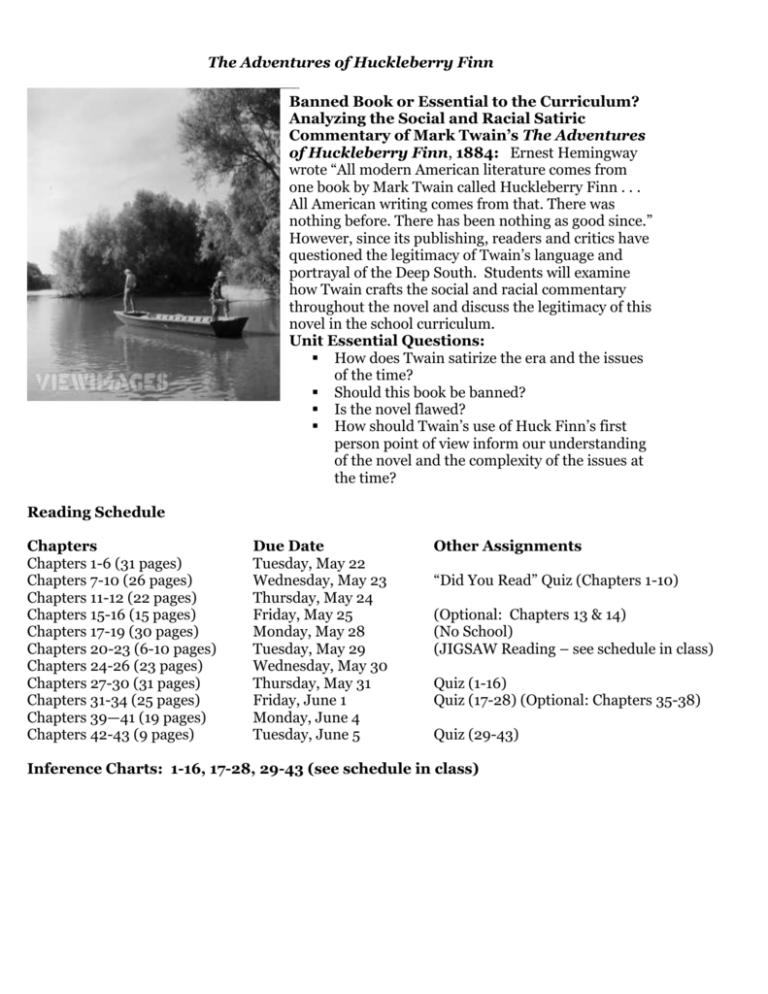
The Adventures of Huckleberry Finn
Banned Book or Essential to the Curriculum?
Analyzing the Social and Racial Satiric
Commentary of Mark Twain’s The Adventures
of Huckleberry Finn, 1884: Ernest Hemingway
wrote “All modern American literature comes from
one book by Mark Twain called Huckleberry Finn . . .
All American writing comes from that. There was
nothing before. There has been nothing as good since.”
However, since its publishing, readers and critics have
questioned the legitimacy of Twain’s language and
portrayal of the Deep South. Students will examine
how Twain crafts the social and racial commentary
throughout the novel and discuss the legitimacy of this
novel in the school curriculum.
Unit Essential Questions:
How does Twain satirize the era and the issues
of the time?
Should this book be banned?
Is the novel flawed?
How should Twain’s use of Huck Finn’s first
person point of view inform our understanding
of the novel and the complexity of the issues at
the time?
Reading Schedule
Chapters
Chapters 1-6 (31 pages)
Chapters 7-10 (26 pages)
Chapters 11-12 (22 pages)
Chapters 15-16 (15 pages)
Chapters 17-19 (30 pages)
Chapters 20-23 (6-10 pages)
Chapters 24-26 (23 pages)
Chapters 27-30 (31 pages)
Chapters 31-34 (25 pages)
Chapters 39—41 (19 pages)
Chapters 42-43 (9 pages)
Due Date
Tuesday, May 22
Wednesday, May 23
Thursday, May 24
Friday, May 25
Monday, May 28
Tuesday, May 29
Wednesday, May 30
Thursday, May 31
Friday, June 1
Monday, June 4
Tuesday, June 5
Other Assignments
“Did You Read” Quiz (Chapters 1-10)
(Optional: Chapters 13 & 14)
(No School)
(JIGSAW Reading – see schedule in class)
Quiz (1-16)
Quiz (17-28) (Optional: Chapters 35-38)
Quiz (29-43)
Inference Charts: 1-16, 17-28, 29-43 (see schedule in class)
Qualities of American Literature
Source: Margaret Reid, A.B., M.A., Ph.D.
Assistant Professor of English, Marquette University.
"American Literature: Prose," Microsoft® Encarta® Online Encyclopedia 2005
http://encarta.msn.com © 1997-2005 Microsoft Corporation. All Rights Reserved.
© 1993-2005 Microsoft Corporation. All Rights Reserved.
American Literature:
Prose, fiction and nonfiction of the American colonies and the United States, written in the English
language from about 1600 to the present. This literature captures America’s quest to understand and define
itself. From the beginning America was unique in the diversity of its inhabitants; over time they arrived
from all parts of the world. Although English quickly became the language of America, regional and ethnic
dialects have enlivened and enriched the country’s literature almost from the start. Today American prose
encompasses a variety of traditions and voices that share a common context: the geographical region now
known as the United States. Native American literatures, which were largely oral at the time of colonial
settlement, stand apart as a separate tradition that is itself strong and varied.
For its first 200 years American prose reflected the settlement and growth of the American colonies, largely
through histories, religious writings, and expedition and travel narratives. Biography also played an
important role, especially in America’s search for native heroes. Fiction appeared only after the colonies
gained independence, when the clamor for a uniquely American literature brought forth novels based on
events in America’s past. With a flowering of prose in the mid-1800s, the young nation found its own voice.
By then fiction had become the dominant literary genre in America. In the 20th century, American
literature took its place on the world stage and began to exert influence on other literatures.
Realism and Naturalism: Twain, Crane, and Others:
Realism entered American literature after the Civil War, soon followed by naturalism, an extreme form of
realism. Naturalism had an outlook often bleaker than that of realism, and it added a dimension of
predetermined fate that rendered human will ultimately powerless.
Samuel Langhorne Clemens, who wrote under the pen name Mark Twain, is sometimes called a regionalist
for his vivid portrayals of Southern character and dialect. However, he also ranks among the great
American realists because he scrupulously included so many sides of life in his works and refused to make
the horrifying look palatable. He published from 1865 until 1910, but his literary fame was firmly rooted in
the 19th century and its crises of racism, class conflicts, and poverty. Twain's works also include some of
the best American humor, starting with the short story "The Celebrated Jumping Frog of Calaveras
County,” which was published in a newspaper in 1865. Twain’s best-known works, The Adventures of Tom
Sawyer (1876) and The Adventures of Huckleberry Finn (1884), are seemingly simple stories that also
offer searing indictments of corruption at all levels of society. The Adventures of Tom Sawyer celebrated
boyhood at the same time that it cleverly revealed the workings of small-town America—small-minded at
times, generous in spirit at other times. The Adventures of Huckleberry Finn is considered Twain’s
masterpiece. In it, the boy Huck Finn learns about human nature’s evil side as well as its kind side. As a
result of his close friendship with a black man who is escaping slavery, Huck also must confront the conflict
between individual intuition about what is right and the prevailing views of society on the subject.
In both Tom Sawyer and Huck Finn, Twain's genius comes through in his realistic depiction of the
psychology and the moral development of his two young characters. Both works are similar in this way to
Little Women (1868-1869), a novel by Louisa May Alcott that records the moral and intellectual coming of
age of four young women. Alcott was the daughter of transcendentalist Bronson Alcott. Her still-popular
novel is one of a series of works that show her serious concern with childhood and adolescence.
Why Teach Huck Finn?
Dr. Shelley Fisher Fishkin, Professor of American Studies and English at the University of
Texas, is the author of Lighting Out for the Territory: Reflections on Mark Twain and
American Culture (Oxford University Press, 1997) and Was Huck Black? Mark Twain and
African American Voices (Oxford University Press, 1993). She is President of the Mark
Twain Circle of America and editor of the 19-volume Oxford Mark Twain.
Despite the fact that it is the most taught novel and most taught work of American literature in American
schools from junior high to graduate school, Huckleberry Finn remains a hard book to read and a hard
book to teach. The difficulty is caused by two distinct but related problems. First, one must understand how
Socratic irony works if the novel is to make any sense at all; most students don't. Secondly, one must be
able to place the novel in a larger historical and literary context -- one that includes the history of American
racism and the literary productions of African-American writers -- if the book is to be read as anything
more than a sequel to The Adventures of Tom Sawyer (which it both is and is not); most students can't.
These two problems pose real obstacles for teachers. Are they surmountable? Under some circumstances,
yes. Under others, perhaps not. I think under most circumstances, however, they are obstacles you can deal
with.
It is impossible to read Huck Finn intelligently without understanding that Mark Twain's consciousness
and awareness is larger than that of any of the characters in the novel, including Huck. Indeed, part of what
makes the book so effective is the fact that Huck is too innocent and ignorant to understand what's wrong
with his society and what's right about his own transgressive behavior. Twain, on the other hand, knows the
score. One must be skeptical about most of what Huck says in order to hear what Twain is saying. In a 1991
interview, Ralph Ellison suggested that critics who condemn Twain for the portrait of Jim that we get in the
book forget that "one also has to look at the teller of the tale, and realize that you are getting a black man,
an adult, seen through the condescending eyes -- partially -- of a young white boy." Are you saying, I asked
Ellison, "that those critics are making the same old mistake of confusing the narrator with the author? That
they're saying that Twain saw him that way rather than that Huck did?" "Yes," was Ellison's answer.
Clemens as a child accepted without question, as Huck did, the idea that slaves were property; neither
wanted to be called a "low-down Abolitionist" if he could possibly help it. Between the time of that
Hannibal childhood and adolescence, however, and the years in which Twain wrote Huckleberry Finn,
Twain's consciousness changed. By 1885, when the book was published, Samuel Clemens held views that
were very different from those he ascribed to Huck. It might be helpful at this point to chart for your
students the growth of the author's developing moral awareness on the subject of race and racism -starting with some of his writings on the persecution of the Chinese in San Francisco (such as Disgraceful
Persecution of a Boy), then moving through his marriage into an abolitionist family, the 1869 anti-lynching
editorial that he published in The Buffalo Express entitled Only a Nigger, and his exposure to figures like
Frederick Douglass and his father-in-law, Jervis Langdon.
By the time he wrote Huckleberry Finn, Samuel Clemens had come to believe not only that slavery was a
horrendous wrong, but that white Americans owed black Americans some form of "reparations" for it. One
graphic way to demonstrate this fact to your students is to share with them the letter Twain wrote to the
Dean of the Yale Law School in 1885, in which he explained why he wanted to pay the expenses of Warner
McGuinn, one of the first black law students at Yale. "We have ground the manhood out of them," Twain
wrote Dean Wayland on Christmas Eve, 1885, "and the shame is ours, not theirs, & we should pay for it."
Ask your students: why does a writer who holds these views create a narrator who is too innocent and
ignorant to challenge the topsy-turvy moral universe that surrounds him?
Something new happened in Huck Finn that had never happened in American literature before. It was a
book, as many critics have observed, that served as a Declaration of Independence from the genteel English
novel tradition. Huckleberry Finn allowed a different kind of writing to happen: a clean, crisp, nononsense, earthy vernacular kind of writing that jumped off the printed page with unprecedented
immediacy and energy; it was a book that talked. Huck's voice, combined with Twain's satiric genius,
changed the shape of fiction in America, and African-American voices had a great deal to do with making it
what it was. Expose your students to the work of some of Twain's African-American contemporaries, such
as Frederick Douglass, Charles Chesnutt, and Paul Laurence Dunbar. Those voices can greatly enrich
students' understanding of both the issues Huckleberry Finn raises and the vernacular style in which it
raises them.
If W.E.B. Du Bois was right that the problem of the twentieth century is the color line, one would never
know it from the average secondary-school syllabus, which often avoids issues of race almost completely.
Like a Trojan horse, however, Huck Finn can slip into the American literature classroom as a "classic," only
to engulf students in heated debates about prejudice and racism, conformity, autonomy, authority, slavery
and freedom. It is a book that puts on the table the very questions the culture so often tries to bury, a book
that opens out into the complex history that shaped it -- the history of the ante-bellum era in which the
story is set, and the history of the post-war period in which the book was written -- and it requires us to
address that history as well. Much of that history is painful. Indeed, it is to avoid confronting the raw pain
of that history that black parents sometimes mobilize to ban the novel. Brushing history aside, however, is
no solution to the larger challenge of dealing with its legacy. Neither is placing the task of dealing with it on
one book.
We continue to live, as a nation, in the shadow of racism while being simultaneously committed, on paper,
to principles of equality. As Ralph Ellison observed in our interview, it is this irony at the core of the
American experience that Mark Twain forces us to confront head-on.
History as it is taught in the history classroom is often denatured and dry. You can keep your distance from
it if you choose. Slaveholding was evil. Injustice was the law of the land. History books teach that. But they
don't require you to look the perpetrators of that evil in the eye and find yourself looking at a kind, gentle,
good-hearted Aunt Sally. They don't make you understand that it was not the villains who made the system
work, but the ordinary folks, the good folks, the folks, who did nothing more than fail to question the set of
circumstances that surrounded them, who failed to judge that evil as evil and who deluded themselves into
thinking they were doing good, earning safe passage for themselves into heaven.
When accomplished fiction writers expose the all-too-human betrayals that well-meaning human beings
perpetrate in the name of business-as-usual, they disrupt the ordered rationalizations that insulate the
heart from pain. Novelists, like surgeons, cut straight to the heart. But unlike surgeons, they don't sew up
the wound. They leave it open to heal or fester, depending on the septic level of the reader's own
environment.
Irony, history, and racism all painfully intertwine in our past and present, and they all come together in
Huck Finn. Because racism is endemic to our society, a book like Huck Finn, which brings the problem to
the surface, can explode like a hand grenade in a literature classroom accustomed to the likes of Macbeth or
Great Expectations -- works which exist at a safe remove from the lunchroom or the playground. If we lived
in a world in which racism had been eliminated generations before, teaching Huck Finn would be a piece of
cake. Unfortunately that's not the world we live in. The difficulties we have teaching this book reflect the
difficulties we continue to confront in our classrooms and our nation. As educators, it is incumbent upon us
to teach our students to decode irony, to understand history, and to be repulsed by racism and bigotry
wherever they find it. But this is the task of a lifetime. It's unfair to force one novel to bear the burden -alone -- of addressing these issues and solving these problems. But Huck Finn -- and you -- can make a
difference.
Major Characters:
Huck Finn- Narrator: A young boy that seeks to run away from home. He is smart and efficient. Huck is
the orphan of an absentee father and a deceased mother. He is uncivilized in manner and habit. He desires
to flee his life, living on a raft, floating down the Mississippi River and doing as he pleases.
Focus: Huck’s awareness of Jim as a person, Huck’s practical morality, the use of Huck’s point of view to
reveal the ironic, brutal horrors of slavery
Jim- A slave on Miss Watson's Plantation who later escapes and becomes Huck's first true friend. He is
searching for his family and freedom. He is very superstitous and religious.
Focus: Jim’s development or lack thereof in order to combat or contribute racist stereotypes
Huck's father- An abusive, drunk old man who is using Huck for his money and advantages.
The Duke and the King- A devious duo who are corrupt and cause trouble. They meet up with Jim and
Huck on the raft and scam cities out of money.
Focus: Irony of these characters’ attitude, how they contribute to realizations and actions of Huck and Jim
Key Themes/issues to explore:
Racism
Legality versus morality
Friendship/Companionship
Freedom/Self Discovery and growth through Journey
Setting- The novel is set in an area of the Mississippi River where Huck and Jim travel on a raft. It also
occurs in several villages where Jim and Huck visit on their journey: Miss Watson's House, the
Grangerford's, Huck's father’s house, Aunt Sally's during the 1840s.
Additional Background Information re: setting and racism
Fugitive Slave Act of 1793
Although Article IV, Section 2 of the United States Constitution guaranteed the right to repossess any
"person held to service or labor" (a euphemism for slaves), it did not set up a mechanism for executing the
law.
On February 12, 1793, the Second Congress passed "An act respecting fugitives from justice, and persons
escaping from the service of their masters," that authorized the arrest or seizure of fugitives and
empowered "any magistrate of a county, city or town" to rule on the matter. The act further established a
fine of $500 against any person who aided a fugitive.
The act was no doubt a response to the proliferation of anti-slavery societies and to the emergence of the
Underground Railroad. Like the Constitution itself, this act does not include a single mention of the words
"slave" or "slavery."
The Fugitive Slave Bill of 1850
The Underground Railroad saw an explosion of activity in the 1840s. In 1842, the Supreme Court ruled in
Prigg v. Pennsylvania that states did not have to aid in the return of runaway slaves.
In an attempt to appease the South, Congress passed the Compromise of 1850, which revised the Fugitive
Slave Bill. The law gave slaveowners "the right to organize a posse at any point in the United States to aid in
recapturing runaway slaves. Courts and police everywhere in the United States were obligated to assist
them" (Blockson, 11). Private citizens were also obligated to assist in the recapture of runaways.
Furthermore, people who were caught helping slaves served jail time as well as pay fines and restitution to
the slaveowner.
“We are all teachers. We are all learners.” – Huck Finn Fishbowl Discussion
Fishbowls are used for dynamic group involvement. The purpose of this activity is to oblige participants (group B) to actively listen
to the experiences and perspectives of their peers (group A) as they interact in a dialogue around a text. Just as people observe fish in
a fishbowl, group B observes group A. Each group will have an opportunity to be in the fishbowl.
Preparation Notes (20 points): MUST BE TYPED AND NOT TO EXCEEED ONE PAGE DOUBLE-SPACED
Overview Set Up:
Include the following elements in one-two paragraphs:
your point of view on the topic (aka your thesis)
at least one citation from a secondary source
at least two citations from the novel (note page numbers)
Notes:
Copy and paste passages that will be used for discussion – use the etext of Huck Finn. Use at least four-five direct textual
quotes.
Type at least six quotes from secondary sources with clear citations (at least two sources required)
Works cited: Type a Works Cited to show your secondary sources.
Participation as “Fish” (40 points): This will be assessed through the teacher rubric provided
Participation as Observers and Note Takers (5 points): Following the discussions, you will be asked to observe the fishbowl
and add on insightful and appropriate comments within your online discussion group.
2 extra credit points for student that volunteers to be a facilitator (only kept if you do an active job of facilitating the discussion)4
Procedure:
1. One important rule must guide the participation of the observers: During the course of the fish bowl, observers are not
allowed to speak. Their job is to listen and learn from the fishbowl students. Remember, use your body language to show that
you are focused, interested, and actively listening.
2. Observers should keep a running log of the dialogue and make note of key points they wish to have clarified, elaborate,
comment on, revisit in some manner, or disagree with. Following each discussion, we will open the group discussion up to the
class at large.
3. One of the fishbowl students will assume the role of facilitator. It will be her/his responsibility to ask questions, facilitate the
fishbowl discussion, and make sure everyone has an opportunity to talk.
4. After the activity, students will have the opportunity to give each other feedback on the process
Ground Rules: Appropriate Behavior
1. Participant states idea and supports with evidence.
2. Participant agrees with previous speaker and adds evidence.
3. Participant disagrees with speaker and offers evidence.
The Adventures of Huckleberry Finn Fish Bowl
Directions: Prepare key passages, quotes, and supporting documents in order to participate constructively in your assigned
discussion group. Within each group you will participate in a 25-30 minute discussion in which you will build on materials, videos,
and discussions made in class. In order to prepare: make a note of key points you find insightful, wish to have clarified, elaborated,
comment on, or revisit in some manner. Additionally, record specific page numbers and passages as well as references to other
materials.
A: Nemos: Some critics assert
that Huck Finn is a racist novel
and should be banned from the
curriculum. Other critics assert
that Huck Finn is essential
American literature that creates
the foundation for
understanding all of American
literature. Within this
discussion, you must touch on
the following subtopics:
-the use of the n word and local
color
-use of dialect
-use of satire as commentary on
societal institutions such as
slavery and religion
-research other relevant
information and passages to this
discussion
-qualities of American literature
B. Guppies: Huck Finn is an
adventure novel that details the
moral growth and development
of Huck Finn during the course
of the novel. How does Twain
depict this growth? Within this
discussion, you must touch on
the following subtopics:
A. Goldies: At first Jim seems
to be a simple character. What
are some ways in which the
author develops him? Within
this discussion, you must touch
on the following sub-topics:
-How does Jim serve as a father
figure to Huck? Contrast him
-the role of secondary characters with Pap Finn
such as the King and the Duke,
-Huck’s changing perceptions of
Jim, the widow, and Tom Sawyer Jim
-the role of religion in Huck’s
-the subtle evolving
development
characterization of Jim (this
-challenges that may be
include other characters
construed as part of the Hero’s
reactions and treatment of Jim)
archetypal journey
-research other relevant
-research other relevant
information and passages to this
information and passages to this discussion
discussion
B. Mahi-Mahis: Some critics
assert that Twain’s storytelling,
especially the ending, is flawed.
What other parts of the novel
may be perceived as flawed or
problematic? Within this
discussion, you must touch on
the following sub-topics:
-Authorial Choice
-different sections of the novel
and how they do or do not
contribute to the novel’s
development
-research other relevant
information and passages to this
discussion
Name: ________________________________________________
Huck Finn Fishbowl Rubric
Group Role:____________________ (Nemos, Goldies, etc.)
Directions: Please submit this rubric at the time of your presentation. Following the fishbowls I will
ask you to attach the preparation materials, note taking and dialogue notes to assess the remainder of
your grade.
Conventions/Delivery of speech
Articulate and clear speech: Employs correct grammar and usage,
5
4 3 2 1
voice control enhances delivery (pace, inflection, enunciation, and volume)
Eye contact: Maintains eye contact with group participants
5
4 3 2 1
No Distractions: avoids interrupters and detractors (“like,” “uhm,” “you 5
4 3 2 1
know,”), as well as any swaying or distracting bodily movement
________/15 points Oral Component Subtotal
Content
Student provides evidence of student knowledge of story as evident by
10 7 5 3 1
reference of textual support (3 references)
Student provides evidence of building on group discussion, by using
5
4 3 2 1
language that connects the discussion (see suggestions on direction sheet)
Student provides evidence of using secondary sources which are clearly
10 7 5 3 1
references in the discussion (3 references)
______/25 Points Content: Oral Presentation Subtotal
Point Total:
__________/40 points
Preparation
________/20 points
Overview includes the following elements:
your point of view on the topic aka your thesis
at least one citation from a secondary source
at least two citations from the novel (note page numbers)
Notes:
four - five direct textual quotes clearly identified.
Six quotes from secondary sources with clear citations (at least two sources)
Works cited:
Participation in the Chat
Reflects the content of the fishbowl
Offers meaningful insights
Stays on topic
Total:
__________/5 points
__________/65 points
Mark Twain and Satire
Key Definitions:
1- Hyperbole (exaggerated exaggeration)
Ex.
2- Verbal Irony (sarcasm)
Ex.
3- Situational Irony (when the opposite of the reader’s expectation occurs)
Ex.
4- Juxtaposition (placing two events together to sharpen the contrast)
Ex.
5- Understatement: the opposite of hyperbole, understatement (or litotes) refers to a figure of
speech that says less than is intended. Understatement usually has an ironic effect, and
sometimes may be used for comic purposes, as in Mark Twain’s statement, "The reports of my
death are greatly exaggerated."
Ex.
6- Parody: a humorous imitation of another, usually serious, work. It can take any fixed or open
form, because parodists imitate the tone, language, and shape of the original in order to deflate
the subject matter, making the original work seem absurd.
Ex.
7- Satire: the use of the above elements to make a critical commentary on some aspect of society.
Sometimes satire is humorous; however, most often it is insightful and biting.
“Extracts from the Diaries of Adam & Eve”
As a class, we will answer the following questions:
Use the following definition of stereotype for common agreement regarding the meaning of the word:
n. A conventional, formulaic, and oversimplified conception, opinion, or image.
WRITE THE DEFINITION ON THE BOARD AND THEN HAVE THEM DO 1 AND 2
1.
2.
3.
4.
Five stereotypes women have about men:
Five stereotypes men have about women
Popcorn read “Extracts from Adam’s Diary” by Mark Twain aloud in your groups
Add two more stereotypes to each list
DO THESE IN A LOOP WRITING EXERCISE BUT IN GROUPS
In small groups (mixed with females and males) students will answer the following on a separate
sheet of paper:
1. Within the text, find five examples of satire – be specific an in-depth with your examples –
explain how they apply to the above listed stereotypes and identify the technique used.
2. As a group discuss whether men and/or women would find this offensive – why or why not?
Take notes on your discussion.
3. The true test of comedy is that it shall awaken thoughtful laughter. In a brief response, explain
how Twain’s extracts prompt a thoughtful response. Is his message subtle or overt and how
does it contribute to the humor?
Following the group activities, students should discuss their responses as a class.
Extracts From Adam and Eve's Diaries
MONDAY.--This new creature with the long hair is a good deal in the way. It is always hanging around and following me
about. I don't like this; I am not used to company. I wish it would stay with the other animals. . . . Cloudy today, wind in
the east; think we shall have rain. . . . WE? Where did I get that word-- the new creature uses it.
TUESDAY.--Been examining the great waterfall. It is the finest thing on the estate, I think. The new creature calls it
Niagara Falls--why, I am sure I do not know. Says it LOOKS like Niagara Falls. That is not a reason, it is mere waywardness
and imbecility. I get no chance to name anything myself. The new creature names everything that comes along, before I
can get in a protest. And always that same pretext is offered--it LOOKS like the thing. There is a dodo, for instance. Says
the moment one looks at it one sees at a glance that it "looks like a dodo." It will have to
keep that name, no doubt. It wearies me to fret about it, and it does no good, anyway. Dodo! It looks no more like a
dodo than I do.
WEDNESDAY.--Built me a shelter against the rain, but could not have it to myself in peace. The new creature intruded.
When I tried to put it out it shed water out of the holes it looks with, and wiped it away with the back of its paws, and
made a noise such as some of the other animals make when they are in distress. I wish it would not talk; it is always
talking. That sounds like a cheap fling at the poor creature, a slur; but I do not mean it so. I have never heard the human
voice before, and any new and strange sound intruding itself here upon the solemn hush of these dreaming solitudes
offends my ear and seems a false note. And this new sound is so close to me; it is right at my shoulder, right at my ear,
first on one side and then on the other, and I am used only to sounds that are more or less distant from me.
FRIDAY. The naming goes recklessly on, in spite of anything I can do. I had a very good name for the estate, and it was
musical and pretty-- GARDEN OF EDEN. Privately, I continue to call it that, but not any longer publicly. The new creature
says it is all woods and rocks and scenery, and therefore has no resemblance to a garden. Says it LOOKS like a park, and
does not look like anything BUT a park. Consequently, without consulting me, it has been new-named NIAGARA FALLS
PARK. This is sufficiently high-handed, it seems to me. And already there is a sign up:
KEEP OFF
Extracts from Eve’s story
SUNDAY.--It is up there yet. Resting, apparently. But that is a subterfuge: Sunday isn't the day of rest; Saturday is
appointed for that. It looks to me like a creature that is more interested in resting than it anything else. It would tire me
to rest so much. It tires me just to sit around and watch the tree. I do wonder what it is for; I never see it do anything…
When I found it could talk I felt a new interest in it, for I love to talk; I talk, all day, and in my sleep, too, and I am very
interesting, but if I had another to talk to I could be twice as interesting, and would never stop, if desired…
NEXT WEEK SUNDAY.--All the week I tagged around after him and tried to get acquainted. I had to do the talking,
because he was shy, but I didn't mind it. He seemed pleased to have me around, and I used the sociable "we" a good
deal, because it seemed to flatter him to be included.
WEDNESDAY.--We are getting along very well indeed, now, and getting better and better acquainted. He does not try to
avoid me anymore, which is a good sign, and shows that he likes to have me with him. That pleases me, and I study to be
useful to him in every way I can, so as to increase his regard. During the last day or two I have taken all the work of
naming things off his hands, and this has been a great relief to him, for he has no gift in that line,
and is evidently very grateful. He can't think of a rational name to save him, but I do not let him see that I am aware of
his defect. Whenever a new creature comes along I name it before he has time to expose himself by an awkward silence.
In this way I have saved him many embarrassments. I have no defect like this. The minute I set eyes on an animal I know
what it is. I don't have to reflect a moment; the right name comes out instantly, just as if it were an inspiration, as no
doubt it is, for I am sure it wasn't in me half a minute before. I seem to know just by the shape of the creature and the
way it acts what animal it is. When the dodo came along he thought it was a wildcat--I saw it
in his eye. But I saved him. And I was careful not to do it in a way that could hurt his pride. I just spoke up in a quite
natural way of pleasing surprise, and not as if I was dreaming of conveying information, and said, "Well, I do declare, if
there isn't the dodo!" I explained--without seeming to be explaining-- how I know it for a dodo, and although I thought
maybe he was a little piqued that I knew the creature when he didn't, it was quite evident that he admired me. That was
very agreeable, and I thought of it more than once with gratification before I slept. How little a thing can make us happy
when we feel that we have earned it!
On the day of the presentations of chapters 1-16, first show them Daisy’s lullaby and Huck Finn in legs as examples!
Chapter Selections:
Group One: 1 and 2
Group Two: 3 and 4
Group Three: 5 and 6
Group Four: 7 and 8
Group Five: 9 and 10
Group Six: 11 and 12
Group Seven: 15 and 16
Name:__________________________________
The Adventures of Huckleberry Finn Review: Chapters 1-16
Directions: As a means of reviewing the text, we will break into partners and write up the following
information for each chapter:
1-With a partner, review your two assigned chapters and decide upon an appropriate title for the
chapters (either separately or, if you’re really ambitious, together!). The title should be an engaging
hook for the chapter that contributes to understanding the important events for each chapter.
Provide a listing of important characters and primary interactions between them as a means of
support. As you list these interactions, think about how they contribute to the different themes in the
novel:
Legality versus morality
Racism
Friendship/Companionship
Freedom/Self Discovery and growth through Journey
2-Twain’s writing occurs with the period of American Realism, known for its acute understanding and
observations of human nature. Henry B. Wonham in “Mark Twain: America’s Regional Author,”
quotes Twain as saying:
the successful artist must be a regional specialist, who has endured ...years and years of
unconscious absorption; years and years of intercourse with the life concerned; of living it,
indeed; sharing personally in its shames and prides, its joys and grief, its loves and hates, its
prosperities and reverses, its shows and shabbiness, its deep patriotisms, its whirlwinds of
political passion, its adorations -- of flag, and heroic dead, and the glory of the national name.
While the foreign writer can register and describe exterior scenes and events, he continued,
only "the native novelist" can provide an accurate representation of the nation's interior
experience, "its soul, its life, its speech, its thought." Literary creativity, according to Twain,
depends on the unconscious accumulation of local knowledge, for the writer is ultimately less a
creator than an ‘Observer of Peoples’ (1).
What traits does Twain reveal throughout his different characterizations and
interactions? Provide two quotes from each chapter that demonstrate your point.
3-As you review you chapter, consider how Twain’s satiric portrayal critically comments on different
issues with Twain’s society. What insight is created? What level of offense is created? Does the
insight outweigh the offense? For this question, consider the following topics:
1-racism/slavery
2-Christianity
3-the South
4-education
Within this section, look for quotes that show the different elements of satire:
1 hyperbole
2 verbal irony (sarcasm)
3 situational irony (when the opposite of the reader’s expectation occurs)
4 juxtaposition (placing two events together to sharpen the contrast)
5 understatement (says less than intended)
6 parody (humorous imitation of another, usually serious, work)
After you have completed all of the above activities, you will need to think of a creative way to
present this information to the class. Remember, I do not want this to be death by Power Point slides.
I am looking for creativity, engagement, and inspiration!
Name: _________________________________________
The Adventures of Huckleberry Finn: Editorial Cartoon
Chapters 17-31, 30 points
Directions: The Adventures of Huckleberry Finn is known for its satiric commentary on the many
and varied ills of Southern society. For this assignment, you will choose one satiric passage from
chapters 17-31 that employs at least two elements of satire (irony, exaggeration, understatement,
juxtaposition, sarcasm (verbal irony)) to reveal the ignorance within society or a flaw within society.
With your partner, identify a key passage from your assigned chapters. Make sure you clear
the passage with me before copying and pasting the passage from the e-text version of the
novel.
15 Points: Analyze the passage for different elements of satire and overall message. Create a
thesis statement specific to the passage that explains how Twain uses satire and for what end.
15 Points: Create an editorial cartoon or a cartoon strip illustrating the passage. If you
reference the n word, write n____. The cartoon should capture the idea of the satiric message
of the passage and use visual element to show the satire. Effort as shown by neatness and
clarity will also be graded.
Sample Passage: Chapter 6
"Oh, yes, this is a wonderful govment, wonderful. Why, looky here. There was a free n___ there from
Ohio -- a mulatter, most as white as a white man. He had the whitest shirt on you ever see, too, and
the shiniest hat; and there ain't a man in that town that's got as fine clothes as what he had; and he
had a gold watch and chain, and a silver-headed cane -- the awfulest old gray-headed nabob in the
State. And what do you think? They said he was a p'fessor in a college, and could talk all kinds of
languages, and knowed everything. And that ain't the wust. They said he could vote when he was at
home. Well, that let me out. Thinks I, what is the country a-coming to? It was 'lection day, and I was
just about to go and vote myself if I warn't too drunk to get there; but when they told me there was a
State in this country where they'd let that n____ vote, I drawed out. I says I'll never vote agin. Them's
the very words I said; they all heard me; and the country may rot for all me -- I'll never vote agin as
long as I live. And to see the cool way of that n____ -- why, he wouldn't a give me the road if I hadn't
shoved him out o' the way” (36).
Example Analysis: Elements seen in the passage: (this does not have to be paragraph
format – I just want to see the thought process that culminated in your thesis
statement)
Juxtaposition of Pap, a dirty, revolting, ignorant, free man to an educated, erudite African
American: the contrast makes Pap’s ignorant rant about race seem ridiculous when comparing
him to the Professor that speaks multiple languages. He is by far the better citizen and yet he
will not be able to vote and will be forced into slavery.
Irony: If Pap wasn’t too drunk to vote, he wouldn’t vote anyway because of the rights given to
African Americans. Given Pap’s ignorance, his statement causes the reader to question: why
would anyone want him to vote? Clearly, his vote does not represent a loss to the country
although he perceives it that way.
Exaggeration: Pap’s overall character represents several stereotypes and negative traits
stacked together – racist, drunkard, uneducated, violent
Thesis statement: Using Pap’s rant, Twain juxtaposes Pap to an educated African American to
reveal ignorance about race and slavery and Pap’s uselessness in society.
Name: ____________________________________
Adventures of Huckleberry Finn Discussion Questions: Chapters 17-31
Essential Questions:
1. How should Twain’s use of Huck Finn’s first person point of view inform our understanding of
the novel and the complexity of the issues at the time? As you consider this question – think
about the elements of Satire
2. Does Mark Twain’s depiction of the South oversimplify the people of the region? Why or why
not?
Bigger Ideas:
Twain’s use of local color; Naturalism
Characterization by comparison/contrast
Foreshadowing
The development of Huck’s conscience with regard to Jim
Commentary on the institution of religion
The Raft: Huck and Jim develop a friendship (Chapters 14-17)
1. What is the nature of Huck and Jim’s relationship? What major decision does Huck pursue?
2. What key incidents occur that serve as a catalyst to evolve Huck’s thinking and perceptions of
Jim?
3. How does Twain satirize the horrors of slavery via Huck’s reactions to Jim’s needs?
4. How do Huck and Jim end up separated?
The Grangerford/Sheperdson Feud (Chapter 18)
1. Why does the feud exist?
2. What is the latest occurrence in the feud (with regard to Ms. Sophia)?
3. From Twain’s perspective, what purpose does the feud serve? Why does he include it in the
novel? Consider the following:
-How the feud foreshadows Huck’s inadvertent involvement in a negative outcome
-How the feud helps Huck to consider the consequences of his actions
-How Huck’s time away from Jim signals more development in their relationship
The King and the Duke (Chapters 19-31)
1. Who are the King and the Duke? How do they interact with Huck and Jim? What are some
examples of the scams they pull? (chapter 19)
2. How do the sub-plots around the King and the Duke make the novel more realistic and add
“local color” to the novel? (chapter 22)
3. Compare and contrast the King and the Duke to Huck Finn – consider their treatment of Jim,
as well as Huck’s scams. How does juxtaposing the King and the Duke’s actions to those of
Huck’s reveal important knowledge with regard to Huck’s character?
4. In chapter 27, the King and the Duke recommend that the slaves be sold. Consider the
different attitudes of the characters involved – what do these attitudes reveal about the
complex, yet problematic mindsets of the time regarding slavery and the rights of African
Americans?
5. What finally happens to Jim as a result of staying with the King and the Duke? What does this
event reveal about Huck’s feelings regarding Jim and the “right, moral thing to do” – read the
passage on page 208 to get a better sense of this.
6. What finally happens to the King and the Duke? Is justice served? How does this final act
contribute to the discussion of Twain’s use of “local color”?
Huck Finn and Tom Sawyer (chapter 33-end)
1. Why does Huck Finn end up masquerading as Tom Sawyer?
2. How does Tom Sawyer change Huck Finn’s plan to rescue Jim? What are the consequences of
these changes?
3. Critics argue that Tom Sawyer’s presence in the novel outshines Huck? Do you agree?
Disagree?
4. How does Tom Sawyer’s change of the rescue plan act as a commentary on the attitude toward
African Americans and slaves at that time?
What other questions or issues should we look at in the novel?

